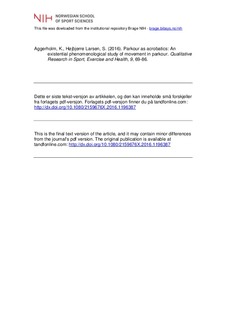Parkour as acrobatics: an existential phenomenological study of movement in parkour
Journal article, Peer reviewed
Accepted version
Permanent lenke
http://hdl.handle.net/11250/2470600Utgivelsesdato
2016-06-14Metadata
Vis full innførselSamlinger
- Artikler / Articles [2096]
Originalversjon
Qualitative Research in Sport, Exercise and Health. 2016, 9, 69-86 10.1080/2159676X.2016.1196387Sammendrag
The aim of this paper is to pursue a novel understanding of parkour. Through an existential phenomenological analysis based on the phenomenology of embodiment and spatiality found in Merleau-Ponty and drawing on Sloterdijk’s philosophical account of acrobatics, we will examine the bodily experience of practitioners in parkour and analyse their process of practising and performing tricks as an acrobatic movement phenomenon. The practitioners use three central terms to describe this process: challenge, break and clean. We use these terms to frame the analysis of how the practitioners are bodily related to what is not yet possible (challenge), how they repeat towards making new tricks possible (break) and how they perfect their bodily experience of moving (clean). Parkour as acrobatics describes the circular and vertical process of revising and refining one’s bodily relation to the world, through which practitioners are continuously attracted to new challenging moves and carve out new possible movements for themselves and others.
Beskrivelse
I Brage finner du siste tekst-versjon av artikkelen, og den kan inneholde ubetydelige forskjeller fra forlagets pdf-versjon. Forlagets pdf-versjon finner du på tandfonline.com / In Brage you'll find the final text version of the article, and it may contain insignificant differences from the journal's pdf version. The definitive version is available at tandfonline.com
